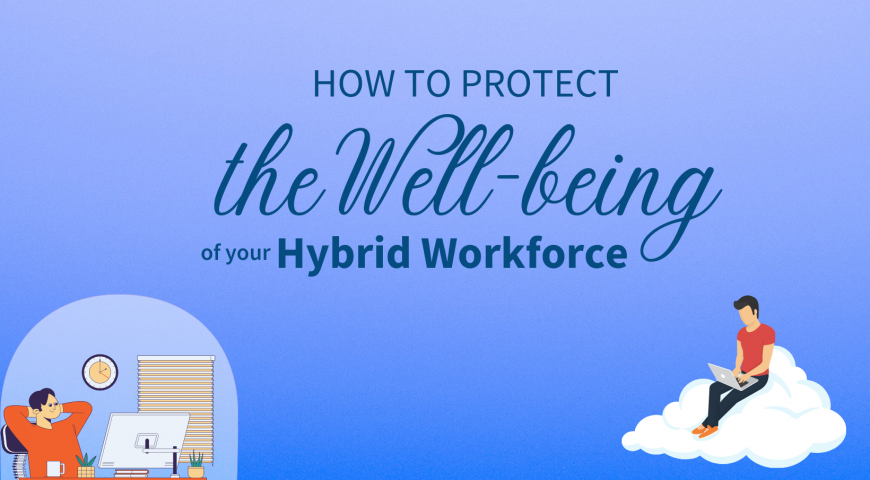When times change, it is the perfect moment to shape a culture. Companies that focus on employee well-being engagement are well-suited to attract the best talent in the generation of hybrid workforce.
The challenge is understanding and supporting employees who have faced immense changes and stress in the past two years.
A 2020 study from Oracle found that “the COVID-19 pandemic has created the most stressful work year in people’s lives, negatively affecting the mental health of 78% of the global workforce.”
As you transition into hybrid work, be transparent to employees about the learning curve and encourage feedback to minimize stress for everyone. Take it slow and make progressive changes as we all face the unknown.
Here are five essential components of a hybrid workforce:
Employee Confidence and Success
Lead with empathy and humanity. Bosses who shine are people’s champions and coaches — a leader that you can open up to and trust because they will protect you.
MIT Sloan determines that the four aspects of leadership in the future are conductor, catalyst, coach, and champion. Their job is to support, remove roadblocks, and foster well-being.
The traditional image of a manager as a slave driver is outdated. Companies have to choose leaders who inspire and cultivate trust — not managers who see burnout as a badge of honor. Long-term, quality work and consistent performance contribute better to company success.
Tip:
Create guidelines to support employee well-being with management training, support, and formal reviews that value work-life balance.
Well-Being
Learn what matters for your employees. The recent workplace changes have opened the room to negotiate employee benefits.
Employee needs vary by gender, cohort, and several other factors. Millennials appreciate work and life balance, while Gen Zs are interested in higher monetary rewards.
In a research by SHRM, 60% of employees place importance on mental health in selecting their next employer. This comes after the pandemic-induced isolation has triggered loneliness, anxiety, and depression.
This is especially true for single millennials and new hires who are yet to form relationships with coworkers.
A hybrid work model reduces isolation. However, it takes more than this to cultivate a culture of openness and inclusion in the hybrid workplace. Encourage socialization at work through virtual events and use tools such as Microsoft Teams and Google Workspace to encourage collaboration.
A streamlined, supportive onboarding program is helpful. Udemy for Business provides tools to upskill employees for digital collaboration. Recognize the importance of employee onboarding and psychological safety. Keep tabs on the well-being of your employees.

Make IT Support Easily Accessible
Removing roadblocks is one of the essential tasks of a manager. Help employees through technical difficulties, so they focus on the work that matters. Have your IT Staff set up Microsoft Teams or Google Workspace for collaboration. Centralize information through Cloud-sharing with Microsoft Azure, AWS Cloud, Google Cloud, or Oracle Cloud. Let them know who to contact if something isn’t right.
Explore long-term and on-demand IT Staffing options with 01 Staffing.
https://www.01staffing.com/employers/
Organizational Culture and Structure
A recent McKinsey study found that “more than three-quarters of C-suite executives expect the typical ‘core’ employee to be back in the office three or more days a week while easing the transition.
Employees feel differently about returning to the office. Those with household responsibilities are more burdened by the commute and adjusting to regular business hours. The preferences of introverts and extroverts vary widely, and women are more likely than men to want to work from home.
Tips for Hybrid Work:
-The most popular hybrid work management plan assumes three days per week in the office and two days at home. But some do it monthly, assuming a certain number of days in the office and at home.
-Manage work and communications fairly. Avoid a two-tier system where employees in the office receive preferential treatment.
-Centralize information through Cloud-sharing.
-Conduct all meetings online. Train employees on tools such as Google Workspace and Office 365, so they can share files, edit together, chat, and conduct business in one efficient virtual workspace.
Communications
In a hybrid workplace. Trust and accountability matter. Tools like Monday.com or Microsoft 365 let managers and teams assign tasks for better visibility. Everyone should know who’s working on what to establish accountability and request updates.
Establishing tasks and asking for regular updates is more productive than conducting daily meetings that do not result in outputs.
Create group chats for different tasks to ensure that only people directly involved in the project are required in the meeting room.
Communicate company and department goals to everyone to encourage initiative and one-mindedness.
4 Ways to Improve Communication
-Leaders should communicate regularly, preferably weekly, to subordinates
-Set expectations and share information ahead
-Meet on video once a week. Share detailed instructions on the email and use chat for quick updates. Attach supporting files on chat and emails. -Use the Microsoft 365 version of Word, Excel, and Powerpoint to edit files together and provide mentorship.
-Everyone should know the vision of the company by heart. Encourage discussion of business trends and how it affects the company. Create safe spaces for sharing ideas.
Explore Google Workspace and Microsoft 365 options for Hybrid Work with 01 Remote.
https://www.01remote.com/managed-microsoft-365/

